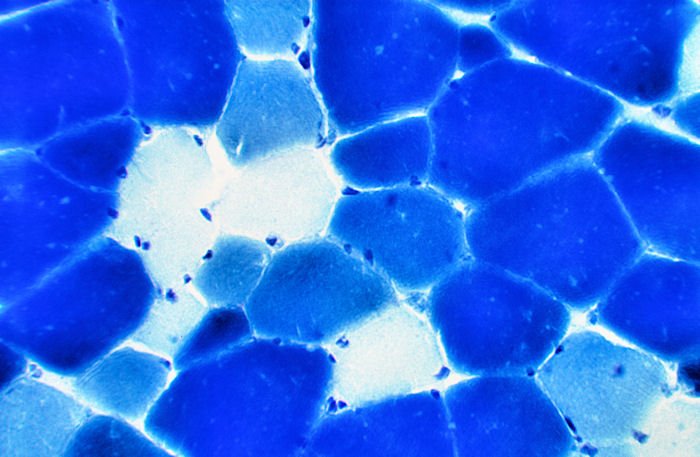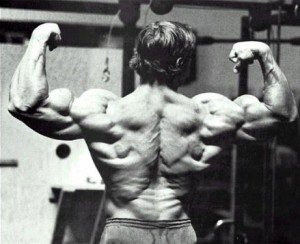Sprinters or marathon runners – a look at our muscle fiber types reveals something surprising.
Properly trained muscles allow you to do deeds that you would never have thought possible before:
- You can run, cycle or swim for hours.
- You develop an almost superhuman strength and speed for seconds.
Perhaps you have already asked yourself one of these questions:
- Why are there people who build muscle faster than others?
- Why are there people who can run faster and longer with less exercise?
- What role do your genes play? Could Schwarzenegger have gone from being a muscle man to a marathon man with the right training?
- Which muscle fibers should you train to achieve your goal as quickly as possible?
The secret – and the answer to these questions – lies within of your muscles. Time to air it.
What is a muscle?

A muscle is an organ that can contract to move part of your body. You have around 650 different muscles.
Every muscle in your body is unique and has a special task.
There are three types of muscles for different requirements in our body: striated muscles, smooth muscles and heart muscles.
- Smooth muscles : The muscles of our intestines, e.g. of the intestine. We cannot control them consciously and yet they work tirelessly in the “background” day after day.
- Heart muscles : The heart muscle consists of striated muscles, but is otherwise completely controlled separately. He also has another important quality: he cannot cramp – not even with a magnesium deficiency.
- Striated muscles (“skeletal muscles”): These are the muscles that interest us. We can consciously tighten and relax them and are – as the name suggests – connected to our bones.
We are interested in the type of muscle that we can consciously control, the striated muscles. When I refer to “muscles” in the following, I mean this type.
The composition of our muscles determines whether you are strong or persistent – possibly both …?
What is a muscle fiber?
Your muscles are connected to the skeletal bone via tendons .
Each muscle consists of individual muscle strands separated from one another by fascia tissue. You can think of a muscle strand as a bundle of many muscle fibers Imagine: A muscle cord unites many individual muscle fibers.
The properties of the muscle fibers can differ considerably: There are different muscle fiber types .
Electron microscope free: Now we zoom in one more step.
A muscle fiber is made up of different types of protein. These proteins form filaments , these are thick and thin structures that slide into one another.
When you tense your muscles, you make sure that these structures slide into each other – the muscle fiber becomes shorter. This force is transmitted to your skeleton via tendons.
This is how you lift weights, stand up, jump or run from your apartment to the gym.
What types of muscle fibers are there?

Now it gets exciting: You have different muscle fiber types that either
- fast and powerful or
- long and not quite as powerful
can contract.
There are three types of muscle fibers:
- Type 1 muscle fibers
- Type 2a muscle fibers
- Type 2b muscle fibers
I know these terms really aren’t that handy. It will be clearer soon!
The three types of muscle fibers differ among other things in:
- Color
- Number of mitochondria (mitochondria are the power plants of the muscle cell – here fat and sugar are converted into the only form of energy that our muscles can use – ATP)
- The speed at which the muscle fiber can contract
- Volume (how “thick” does the muscle fiber get when it gets stronger?)
The exciting question is …
Which muscle fiber types do sprinters, which marathon runners?
Marathon runners need excellently trained type 1 muscle fibers. If you like to swim or climb, you need the 2a muscle fiber type. And if you want to look good naked, you shouldn’t neglect your type 2b muscle fibers.
Muscle fiber type 1 – The marathon runner (> 30 min. load)

Color: red- Fatigue: very slowly
- Mitochondria: very many
- Contraction: slowly
- Force: low
- Volume: thinner
- Type of sport: long-distance running, bike racing, triathlon, marathon, ironman (continuous exercise over 30 minutes)
This type of muscle fiber is also called slow twitch – slowly contracting.
Muscle fiber type 2a – the middle-distance runner (1-30 min. load)

color: red- Fatigue: slowly
- Mitochondria: many
- Contraction: relatively fast
- Strength: medium
- Volume: thicker
- Type of sport: medium-distance running, swimming, climbing (continuous exposure of less than 30 minutes)
Muscle fiber type 2b – The weightlifter (

color: white- Fatigue: fast
- Mitochondria: few
- Contraction: very fast
- Power: high
- Volume: thicker
- Type of sport: sprinting, weightlifting, gymnastics (continuous exposure of less than 60 seconds)
Muscle fiber type 2 is also called fast twitch – fast contracting.
Which muscle fiber type are you: sprinter or marathon runner?

Every muscle has all three muscle fiber types. The amount matters: the higher the proportion of a certain muscle fiber type, the greater your potential.
The exciting question is therefore: How well are you equipped with the respective muscle fiber type?
As is so often the case, it depends. The number of individual fibers essentially depends on two factors:
- Function : What is the task of the muscle tissue?
- Predisposition : What is the distribution of your genes?
You will soon see why training does NOT influence this distribution – and why it is still important.
Muscle fiber type distribution # 1: What is the function of the muscle?
Each muscle in your body is exposed to different loads and has to perform different tasks. And the composition of the muscle fiber types is just as different.
Depending on its function, a muscle has more enduring or powerful muscle fibers.
For example the muscles that ensure an upright posture: back extensors, hip flexors, calves, etc.
Normally you don’t need a lot of strength to do this, but you have to be under tension for hours. So Mother Nature has given you a large percentage of Type 1 muscle fibers.
Your body is intelligent. If you use a muscle in sports or in everyday life, it will only use the muscle fiber type that does the job and uses the least amount of energy:
- If you use little force, you will only contract type 1 muscle fibers – the type 2 muscle fibers remain relaxed. Example: Go.
- If you need a lot of strength, the following happens: First, your body tries (For athletes we want to recommend boldenon kur) to cope with the load only with type 1 muscle fibers and only then switches on type 2a and finally type 2b muscle fibers. Example: barbell deadlift in the muscle building area
Quiz question: Can Haile Gebrselassie become a Schwarzenegger if he works hard?
Muscle fiber type distribution # 2: Can a marathon runner become a bodybuilder?

Maybe you know such people in your sporting environment: The ones who, with obscene little training, are among the fastest in the fun run.
And then there are the cardio refusers who just look at a barbell to build muscle.
Everyone is born with a certain proportion of the different muscle fiber types.
You are predisposed to be a sprinter, weightlifter or long-distance runner.
Science has been divided as to whether your body can convert one type of muscle fiber into another. So we assume that you can get along with what your parents gave you.
Fortunately, the story doesn’t end there!
With proper training, the muscle fiber types you are equipped with become more efficient.
With proper training you do not change the number , but the proportion of the fast and slow twitching muscle fibers in the muscle cross-sectional area.
The more area your type 2 muscle fibers occupy in the overall muscle cross-section, the higher your maximum and speed strength – and the better the conditions for muscle building.
If you want to look good naked, you can train the right muscle fiber types. In addition, you can align all factors, muscle building, endurance training and nutrition, to your goal.
Some people – they call themselves hardgainers – have a harder time building muscle than others. Very few of them know that it is not the distribution of the muscle fiber types, but their eating habits that are the limiting factor.
Conclusion
Whether sprinter, weightlifter, marathon runner or triathlete – the secret of our physical performance lies in the performance of the individual muscle fiber types. You probably can’t change how many muscle fibers you have of each type. So you can play with the cards that your parents gave you.
Maybe you are not equipped with the type 1 muscle fibers of an Olympic marathon runner or the type 2 fibers of a world class sprinter or bodybuilder. But it doesn’t matter, after all, you don’t want an Olympic gold medal, you want to look good naked.
The good news for those who stay tuned: If you are ready to train your muscle fibers properly, you will achieve your goal. If you belong to the group of hard gainers, you can put an additional focus on your diet.



